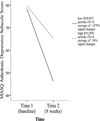Reduced right ventrolateral prefrontal cortex activity while inhibiting positive affect is associated with improvement in hedonic capacity after 8 weeks of antidepressant treatment in major depressive disorder
- PMID: 21867991
- PMCID: PMC3200460
- DOI: 10.1016/j.biopsych.2011.06.031
Reduced right ventrolateral prefrontal cortex activity while inhibiting positive affect is associated with improvement in hedonic capacity after 8 weeks of antidepressant treatment in major depressive disorder
Abstract
Background: Anhedonia, a reduced ability to experience pleasure, is a chief symptom of major depressive disorder and is related to reduced frontostriatal connectivity when attempting to upregulate positive emotion. The present study examined another facet of positive emotion regulation associated with anhedonia-namely, the downregulation of positive affect-and its relation to prefrontal cortex (PFC) activity.
Methods: Neuroimaging data were collected from 27 individuals meeting criteria for major depressive disorder as they attempted to suppress positive emotion during a positive emotion regulation task. Their PFC activation pattern was compared with the PFC activation pattern exhibited by 19 healthy control subjects during the same task. Anhedonia scores were collected at three time points: at baseline (time 1), 8 weeks after time 1 (i.e., time 2), and 6 months after time 1 (i.e., time 3). Prefrontal cortex activity at time 1 was used to predict change in anhedonia over time. Analyses were conducted utilizing hierarchical linear modeling software.
Results: Depressed individuals who could not inhibit positive emotion-evinced by reduced right ventrolateral prefrontal cortex activity during attempts to dampen their experience of positive emotion in response to positive visual stimuli-exhibited a steeper anhedonia reduction slope between baseline and 8 weeks of treatment with antidepressant medication (p < .05). Control subjects showed a similar trend between baseline and time 3.
Conclusions: To reduce anhedonia, it may be necessary to teach individuals how to counteract the functioning of an overactive pleasure-dampening prefrontal inhibitory system.
Trial registration: ClinicalTrials.gov NCT00909155.
Copyright © 2011 Society of Biological Psychiatry. Published by Elsevier Inc. All rights reserved.
Conflict of interest statement
Figures



References
-
- Wager TD, Sylvester CY, Lacey SC, Nee DE, Franklin M, Jonides J. Common and unique components of response inhibition revealed by fMRI. NeuroImage. 2005;27:323–340. - PubMed
-
- Keedwell PA, Andrew C, Williams SC, Brammer MJ, Phillips ML. The neural correlates of anhedonia in major depressive disorder. Biol Psychiatry. 2005;58:843–853. - PubMed
-
- Kumari V, Mitterschiffthaler MT, Teasdale JD, Malhi GS, Brown RG, Giampietro V, Brammer MJ, Poon L, Simmons A, Williams SC, Checkley SA, Sharma T. Neural abnormalities during cognitive generation of affect in treatment-resistant depression. Biol Psychiatry. 2003;54:777–791. - PubMed
Publication types
MeSH terms
Substances
Associated data
Grants and funding
LinkOut - more resources
Full Text Sources
Medical
Miscellaneous

